Diplomatic Bluebook 2021
Chapter 5
Japan's Diplomacy Open to the Public
2 Strengthening the Foreign Policy Implementation Structure
The security environment surrounding Japan has become even more severe, and changes in the power balance of the international community accelerate and become more complex. Amid such a situation, and also amid the spread of COVID-19, MOFA must enhance its foreign policy implementation structure while looking ahead to the post-COVID-19 world, in order to pursue flexible diplomacy and promote diplomacy that ensures the safety and security of Japanese nationals. To that end, MOFA is strengthening both the quantity and quality of its diplomatic missions overseas, and reinforcing the organizational and personnel structures at its headquarters.
Diplomatic missions overseas, such as embassies and consulates-general, not only represent Japan and promote diplomatic agenda, but also play a key role in areas such as information-gathering and strategic communication at the frontline of diplomacy. At the same time, overseas missions also carry out operations directly related to enhancing the interests of Japanese nationals, such as protecting their lives and safety, providing support for Japanese companies, promoting investment and tourism, and securing energy and other resources.
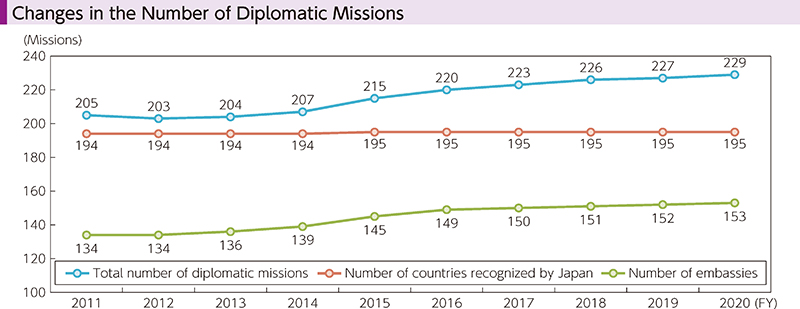
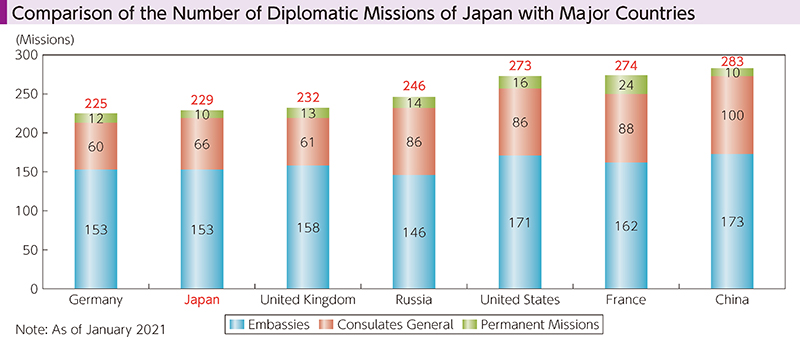
In January 2021, Japan established a new embassy in Haiti and a new consulate-general in Cebu in the Philippines. As a result, the number of diplomatic missions overseas as of FY2020 is 229 (153 embassies, 66 consulates general and 10 permanent missions).
While Haiti has the largest population in the Caribbean Community, it is also the poorest country in Latin America and the Caribbean, and interest from the international community over the country remains high amidst its frequently-occurring natural disasters. Haiti is also traditionally one of the friendliest countries to Japan that has supported many of Japan's positions in the international arena. Cebu is the second-largest metropolitan area in the Philippines after Manilla. In recent years, there has been a significant increase in the number of Japanese companies and travelers, such as tourists and language students in Cebu and the Visayas region at large. By establishing the embassy in Haiti and consulate-general in Cebu, Japan will not only build a higher level of bilateral relations with the both countries, it will also strengthen its capacity to protect Japanese nationals, support Japanese companies and cooperate in the international arena.
In FY2021, Japan will establish a new consulate-general in Da Nang in Viet Nam. Da Nang is achieving remarkable economic growth, and the numbers of Japanese companies in operation and Japanese nationals living there are both increasing. Additionally, Da Nang occupies an important position on the security front facing the South China Sea. Since it is situated at the starting point of the East-West Economic Corridor, Da Nang is recognized as one of important strategic locations toward promoting “Free and Open Indo-Pacific” (FOIP). It is essential for Japan to deepen its relations with the Da Nang region in a multi-layered manner by establishing a basis for information gathering on security and economic affairs in the area.
In addition to establishing more diplomatic missions overseas, it is important to secure and increase the number of staff members to support diplomacy at the MOFA headquarters and diplomatic missions overseas. In the context of the Government's policy to reduce the overall personnel expenses due to the current severe budget situation, the number of staff members at MOFA was increased to 6,358 (6,288 in 2019) in order to advance Japan's “Proactive Contribution to Peace” policy, implement protection and safety measures for Japanese nationals abroad, strengthen information-gathering and analysis capabilities, further vitalize the Japanese economy including the promotion of infrastructure exports, advance strategic communications, and address bilateral relations and regional situations. The number of staff members, however, remains insufficient in comparison with other major countries. MOFA continues its efforts to build a structure that is commensurate with Japan's national power and diplomatic policy. In the meantime, based on the belief that enhancing the foreign policy implementation structure remains essential in FY2021, MOFA will increase its workforce by 72 staff.
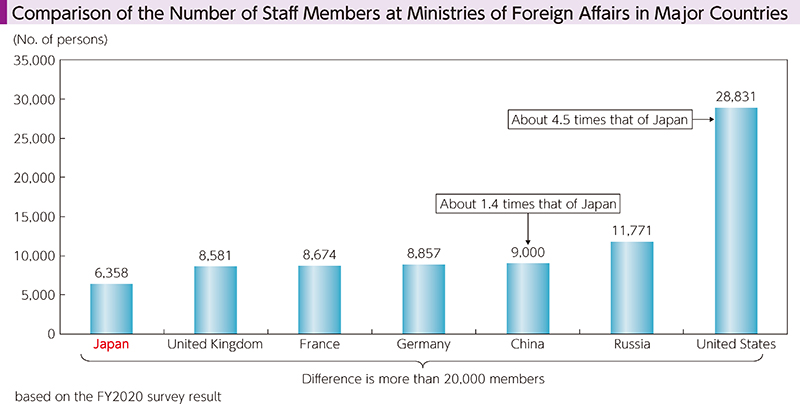
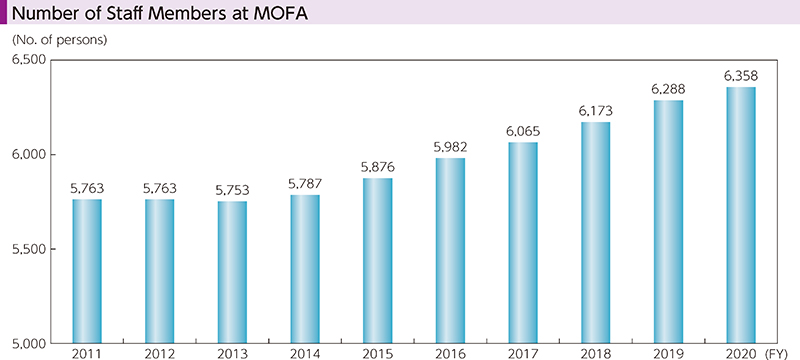
Furthermore, MOFA appropriated a budget of 712.0 billion yen in the budget for FY2020 (an increase of 18.6 billion yen from FY2019) in order to realize FOIP and fortify the structure for strengthening the international order based on the rule of law. As for MOFA's FY2020 supplementary budgets, it appropriated a budget of 102.8 billion yen in the first supplementary budget, 2.1 billion yen in the second supplementary budget, and 134.9 billion yen in the third supplementary budget. The funding appropriated in the first supplementary budget was chiefly for supporting the halting and prevention of the spread of COVID-19 in developing countries in Asia, Oceania, the Middle East, Africa, Central and South America and other regions in order to mitigate the impact of COVID-19, and for supporting Japanese companies overseas. Similarly, in the third supplementary budget, MOFA appropriated funding for halting the global spread of COVID-19 and supporting people being affected by the impact of that.
MOFA's FY2021 initial government budget proposal appropriated 709.7 billion yen (of which a digital-related budget of 13.8 billion yen is appropriated under the Cabinet Secretariat budget) based on the following priorities: (1) overcoming COVID-19, which poses a threat to human security, while also moving forward with initiatives that look ahead to the post-COVID-19 world; (2) promoting “diplomacy with a sense of caring” in order to preserve the safety of Japan and its nationals; and (3) promoting “diplomacy with robustness” in order to further advance collaboration and cooperation with the international community. Within that, in order to bolster support for developing countries in the healthcare and medical fields, the budget for providing assistance bilaterally and through international organizations has been enhanced. Additionally, partly based on experiences under the spread of COVID-19, the budget for evacuating Japanese nationals in emergency situations, the budget for charter flights for the Foreign Minister and related budgets have been enhanced and appropriated as budgets deemed necessary for bolstering the protection of Japanese nationals overseas, including in responding to emergency situations, and for the continuous implementation of diplomatic and consular duties. In addition, MOFA also appropriated funding for hosting conferences and meetings to strengthen cooperation with allies and like-minded countries, creating new rules to be effective in space and cyberspace, and other matters.
In order to promote Japan's national interests, Japan will continue to proceed strategically to develop the foreign policy implementation structure and enhance it further, while making efforts to streamline operations.
Executive Chefs for ambassadors/consuls-general of Japan are licensed cooks or persons with a considerable experience working as chefs, who have been recognized by the Minister for Foreign Affairs to engage in official catering work at official residences and other venues for the head of a diplomatic mission overseas (ambassador/consul-general). Diplomatic missions overseas are the center for diplomatic activities such as negotiations with governments, information gathering, and the development of personal networks. One of the most effective means of diplomacy is to create opportunities for meals at the official residence of the ambassador/consul-general, with guests such as influential politicians, businessmen and government officials from the country of assignment, as well as the diplomatic corps from various countries. For this reason, the head of the diplomatic mission is usually accompanied by the Executive Chef for the ambassador/consul-general, an exclusively appointed chef whose aim is to provide high-quality meals.
Unfamiliar ingredients and Japanese cuisine: Activities during the COVID-19 pandemic
Shingu Takeo, Executive Chef for the Consul-General of Japan in Rio de Janeiro
After serving as the Executive Chef for the Consul-General of Japan in Milano, I started working as the Executive Chef of Mr. Otsuru, Consul-General in Rio de Janeiro, from November 2019. Before working as an Executive Chef, I visited 13 countries around the world and actively tried out various ingredients from all parts of the world. As I discovered new ingredients, I aspired to become an Executive Chef and I wanted to convey the wonderful qualities of Japanese cuisine by using local ingredients.
To serve up delicious Japanese cuisine, it is important to ensure that the ingredients are fresh. In this hot country where it is possible to swim in the sea even in winter, I was worried that I might not be able to obtain seafood that can be used to make sashimi and sushi. However, fresh seafood is surprisingly available in abundance. Furthermore, Japanese immigrants came to Brazil in 1908, and they have since created the world's largest Nikkei (Japanese immigrants and their descendants) community of about 2 million people here. Through their efforts, many Japanese vegetables and fruits are now produced in Brazil. Hence, it is possible to buy vegetables such as cucumbers and Japanese white radish at supermarkets and open-air markets, and the Japanese names of some ingredients have even been introduced into Portuguese, the official language of Brazil (for example, shiitake mushrooms (shitake), shimeji mushrooms (shimeji), Chinese leeks (nirá), and persimmon (caqui)).
By contrast, I incorporate unique Brazilian ingredients into my Japanese cuisine. For example, the plant known as jambu has a flower that is numbing like the Japanese pepper, so it can be boiled or sprinkled over spicy dish of “mapo tofu.” Its leaf is delicious when boiled in soy sauce and served as tsukudani. Cará is an ingredient similar to yam, and it is very useful as a binding agent. Fish from the trout family in the Amazon region are fatty and go well with rice when served with grated Japanese white radish, soy sauce, and lemon. Açaí and acerola are well known even in Japan, but the local açaí tastes completely different from the açaí available in Japan. Freshly picked açaí has a raw, grassy smell and a mushy texture. However, adding a little sugar gives it a refreshing taste and makes it surprisingly delicious.
There are three dishes on my menu that I would definitely like guests to enjoy. The first is the roasted or grilled dish. For this, I serve up beef that has been cooked at a low temperature for two hours, with a passionfruit sauce. For the steamed dish, I serve up seafood and bamboo shoots in Japanese steamed egg custard (chawanmushi), covered in a prawn-based sauce stewed for two days. For the fried dish, I present fresh prawn tempura with powdered green tea (matcha) and salt. These are three dishes that I always serve guests attending a meal for the first time, and I am glad that they have been well received by all the guests.
Unfortunately, due to the impact of the COVID-19 pandemic, there was a period from April 2020 when we could not host any meals. During this period, I published videos through the Consul-General's official Instagram account, introducing recipes for Japanese cuisine made with local ingredients that can also be prepared at home by the general public in Brazil. The recipe video for tempura was especially popular. Viewers were also interested to find out that the word tempura, a representative dish in Japanese cuisine, comes from the Portuguese word tempero (meaning “seasoning”). Since around August 2020, we have been able to host meals again for small groups with adequate measures against COVID-19 in place.
As there are still many ingredients in Brazil that I do not know about, I will continue to learn diligently, in order to incorporate such ingredients into the making of delicious Japanese cuisine.
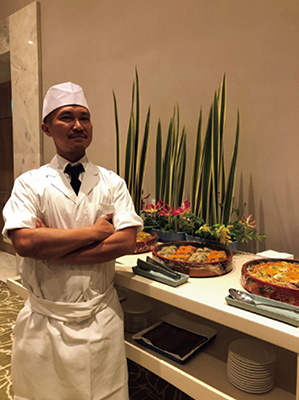 At the reception for celebrating the birthday of His Majesty the Emperor
At the reception for celebrating the birthday of His Majesty the Emperor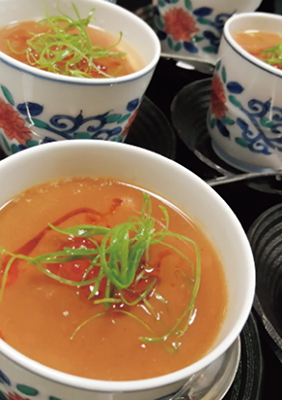 Steamed dish (Seafood chawanmushi)
Steamed dish (Seafood chawanmushi)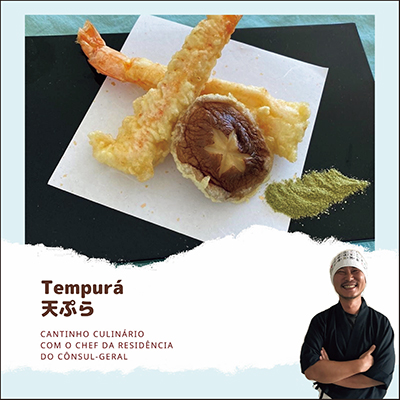 Publishing videos on Japanese cuisine on Instagram
Publishing videos on Japanese cuisine on InstagramThe Ministry of Foreign Affairs accepts applications at any time from candidates who wish to serve in diplomacy as Executive Chefs for ambassadors/consuls-general of Japan.
If you are interested, please inquire through the following website or the QR code.
[International Hospitality and Conference Service Association.
http://www.ihcsa.or.jp/zaigaikoukan/cook-1/]

You can also read more about the activities of Executive Chefs for ambassadors/consuls-general of Japan through the “MOFA Japan Chef” social media accounts (Facebook and Twitter).
Facebook:
https://www.facebook.com/MofaJapanChef

Twitter:
https://twitter.com/mofa_japan_chef

(only in the Japanese language)

